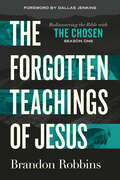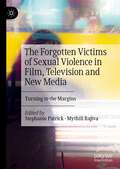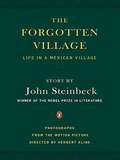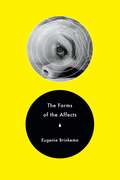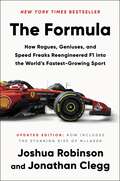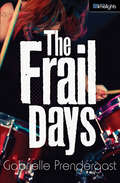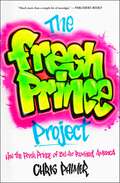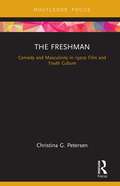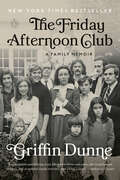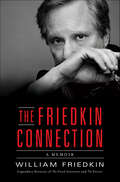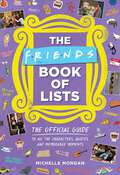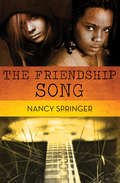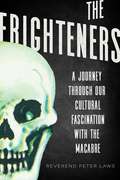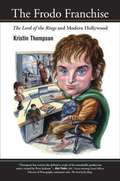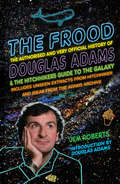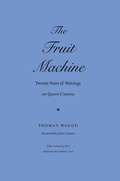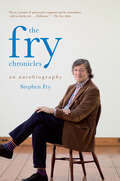- Table View
- List View
The Forgotten Teachings of Jesus: Rediscovering the Bible with The Chosen: Season One
by Brandon RobbinsThe Chosen brings Jesus&’ teachings to the screen. Now bring additional understanding of His teachings to your life. A captivating exploration of New Testament living and traditions, this immersive book from one of the most popular commentators on the beloved television series takes readers on a spiritual journey to see Jesus and comprehend the Bible like never before. With over 100 million viewers since its debut, the award-winning television show The Chosen continues to captivate people around the world. In this spiritually profound book, Pastor Brandon Robbins explores the nuances of the first eight episodes of The Chosen to help us understand the heart of season 1: what it means to be a disciple of Jesus. In The Forgotten Teachings of Jesus, Brandon provides: An in-depth look at The Chosen&’s first season with four short, accessible chapters per episode Fascinating historical and cultural details to enhance your appreciation for the show and your understanding of the Bible Fresh perspective on favorite Bible stories and insight into how events on The Chosen connect with biblical truths Whether you&’re a devoted fan or simply curious about the series, The Forgotten Teachings of Jesus will enrich your understanding of The Chosen but most importantly ignite your desire to know Jesus more. With over 100 million viewers since its debut, the award-winning television show The Chosen continues to captivate people around the world. This immersive book from one of the most popular commentators on the beloved television series helps us see the show as well as the Bible with new eyes.
The Forgotten Teachings of Jesus: Rediscovering the Bible with The Chosen: Season Two
by Brandon RobbinsJames and John struggle with their tempers, earning the nickname “Sons of Thunder.”Jesus sees Nathanael’s pain and offers soul-deep healing.The Pharisees grow suspicious of Jesus’s fame, even as the disciples help Him gather a crowd for one of the most powerful moments in world history.The second season of The Chosen immerses us again in the world of Jesus, His disciples, and His mission. Walk through the historical and cultural reality of every episode with pastor and popular Chosen commentator Brandon Robbins in this spiritually rich guide.Jesus’ growing ministry is stirring hearts—and stirring trouble. As new followers join Him, tensions rise among the disciples, religious leaders, and even Rome. From miraculous healings to intimate conversations, the events of The Chosen: Season 2 build toward Jesus’s foundational mountaintop teaching on how to live.With four chapters for each of the eight episodes, this companion guide offers fascinating historical context and biblical insights to show us how:God calls imperfect people—fiery tempers, broken pasts, and all.Faith extends beyond cultural traditions, societal lines, and even our own assumptions.Jesus heals not just individuals but relationships.Followers of Jesus may have conflict, disagreement, or even hurt one another, but love for Jesus can hold them together.Jesus models mercy over law, compassion over rules, and freedom over fear.Discover the life-changing truths behind the most compelling moments of The Chosen’s second season. As you step into the disciples’ shoes like never before, you’ll realize along with Jesus’ earliest followers that every moment in your journey prepares you for what’s next.
The Forgotten Victims of Sexual Violence in Film, Television and New Media: Turning to the Margins
by Stephanie Patrick Mythili RajivaThis edited collection provides an intersectional and transnational exploration of representations of sexual violence and rape within films, television shows, and digital media in the contemporary context of the #MeToo and #TimesUp movements. Drawing upon sociology, gender studies, cultural studies, media studies, and Black feminist studies, chapters focus on women and texts at the margins of mainstream culture’s depictions of sexual violence. The editors and contributors examine the dominant narrative of the thin, cisgender, heterosexual white female victim, and the ways in which social and cultural conversations around race and gender impact and are impacted by depictions of sexual violence in media. This book will be of interest to scholars and students in sociology, gender studies, and media studies, particularly those interested in the intersectionality of race and gender.Chapter 1 is available open access under a Creative Commons Attribution 4.0 International License via link.springer.com.
The Forgotten Village: Life in a Mexican Village
by John Steinbeck Alexander Hackensmid Rosa Harvan KlineThe novelist who wrote The Grapes of Wrath and the director who produced Crisis and Lights Out in Europe combined their superb talents to tell the story of the coming of modern medicine to the natives of Mexico. There have been several notable examples of this pen-camera method of narration, but The Forgotten Village is unique among them in that the text was written before a single picture was shot. The book and the movie from which it was made have, thus, a continuity and a dramatic growth not to be found in the so-called "documentary" films. The camera crew that, headed by Kline and with Steinbeck's script at hand, recorded this narrative of birth and death, of witch doctors and vaccines, of the old Mexico and the new, spent nine months off the trails of Mexico. They traveled thousands of miles to find just the village they needed; they borrowed children from the government school, took men from the fields, their wives from the markets, and old medicine woman from her hut by the side of the trail. The motion picture they made (for release in 1941) is 8000 feet long. From this wealth of pictures 136 photographs were selected for their intrinsic beauty and for the graceful harmony with which they accompany Steinbeck's text. This new script-photograph technique of narration conveys its ideas with unexcelled brilliance and immediacy. In the hands of such master story-tellers as Steinbeck and Kline, it makes the reader catch his breath for the beauty and the truth of the tale.
The Formation of Chinese Art Cinema: 1990-2003
by Li YangThe Formation of Chinese Art Cinema: 1990–2003 examines the development of Chinese art film in the People’s Republic of China from 1990, when the first Sixth Generation film Mama was released, to 2003, when authorities acknowledged the legitimacy of underground filmmakers. Through an exploration of the production and consecration mechanisms of the new art wave and its representative styles, this book argues that the art wave of the 1990s fundamentally defined Chinese art cinema. In particular, this vital art wave was not enabled by democratic liberalism, but by the specific industrial development, in which the film system transitioned from Socialist propaganda into a commercialized entity. Allowing Chinese art film to grow but at the same time denying its legitimacy, this paradoxical transition process shaped Chinese art film’s institutional and aesthetical alternative positioning, which eventually helped consolidate the art wave into art cinema. Ultimately, this book is a history of the Chinese portion of global art cinema, which also reveals the complex Chinese cultural experiences during the Reform Era.
The Forms of the Affects
by Eugenie BrinkemaWhat is the relationship between a cinematic grid of color and that most visceral of negative affects, disgust? How might anxiety be a matter of an interrupted horizontal line, or grief a figure of blazing light?Offering a bold corrective to the emphasis on embodiment and experience in recent affect theory, Eugenie Brinkema develops a novel mode of criticism that locates the forms of particular affects within the specific details of cinematic and textual construction. Through close readings of works by Roland Barthes, Hollis Frampton, Sigmund Freud, Peter Greenaway, Michael Haneke, Alfred Hitchcock, Søren Kierkegaard, and David Lynch, Brinkema shows that deep attention to form, structure, and aesthetics enables a fundamental rethinking of the study of sensation. In the process, she delves into concepts as diverse as putrescence in French gastronomy, the role of the tear in philosophies of emotion, Nietzschean joy as a wild aesthetic of repetition, and the psychoanalytic theory of embarrassment. Above all, this provocative work is a call to harness the vitality of the affective turn for a renewed exploration of the possibilities of cinematic form.
The Formula: How Rogues, Geniuses, and Speed Freaks Reengineered F1 into the World's Fastest-Growing Sport
by Joshua Robinson Jonathan CleggAn NPR Best Book of 2024A Sports Illustrated Best Book of 2024NEW YORK TIMES BESTSELLERWall Street Journal reporters and authors of The Club, Joshua Robinson and Jonathan Clegg tell the riveting saga of how Formula 1 broke through in America, detailing the eclectic culture of racing obsessives, glamorous settings, gearheads, engineering geniuses, dashing racers, and bitter rivalries that have made F1 the world’s fastest growing sport.For decades in America, car racing meant NASCAR, and to a lesser extent IndyCar, with Formula 1—the wealthiest racing league in the world—a distant third. Fast forward to 2023, and F1 has emerged at the front of the pack powered by a passionate yet nascent American fanbase. The F1 juggernaut has arrived, but this checkered flag was far from inevitable.In The Formula, Wall Street Journal reporters Joshua Robinson and Jonathan Clegg tell the epic story of how F1 saved itself from collapse and finally conquered America through guile, fearlessness, and above all, reinvention. With fast cars, big money, glamorous locales, and beautiful people as the backdrop, The Formula reveals how F1’s sudden arrival in the US was actually decades in the making, a product of the sport’s near-constant state of transformation and experimentation. Bringing unique insight and access to F1’s most storied teams and personalities—from Ferrari to Bernie Ecclestone to Christian Horner to Lewis Hamilton—The Formula offers a riveting portrait of the drivers, corporations, cars, rivalries, and audacious gambles that have shaped the sport for half a century.The end result is a high-octane history of how modern F1 racing came to be—the first book to tell the story of the outrageous successes and spectacular crashes that led F1 to this extraordinary yet precarious moment. More than just a sports story, The Formula is the tale of a disrupter that broke into the crowded American sports marketplace and claimed its place through cash, personality, and a new understanding of what a sport needs to be in the age of wall-to-wall entertainment.
The Foundling: The True Story of a Kidnapping, a Family Secret, and My Search for the Real Me
by Paul Joseph FronczakThis is the inspiring and &“page-turning&” (Booklist) true story of a man who discovered that he had been kidnapped as a baby—and how his quest to find out who he really is upturned the genealogy industry, his own family, and set in motion the second longest cold case in US history.In 1964, a woman pretending to be a nurse kidnapped an infant boy named Paul Fronczak from a Chicago hospital. Two years later, police found a boy abandoned outside a variety store in New Jersey. The FBI tracked down Dora Fronczak, the kidnapped infant&’s mother, and she identified the abandoned boy as her son. The family spent the next fifty years believing they were whole again—but Paul was always unsure about his true identity. Then, four years ago—spurred on by the birth of his first child, Emma Faith—Paul took a DNA test. The test revealed that he was definitely not Paul Fronczak. From that moment on, Paul has been on a tireless mission to find the man whose life he&’s been living—and to discover who abandoned him, and why. Poignant and inspiring, The Foundling is a story about a child lost and a faith found, about the permanence of families and the bloodlines that define you, and about the emotional toll of both losing your identity and rediscovering who you truly are.
The Fourth Wish
by Lindsay RibarHere's what Margo McKenna knows about genies: She's seen Aladdin more times than she can count; she's found a magic genie ring and made her three allotted wishes; she's even fallen head over heels in love with Oliver, the cute genie whose life she saved by fighting off another genie. But none of this prepared her for the shock of becoming a genie herself. Everything Margo's taken for granted--graduating high school, going to college, hating math, performing in the school musical, even being a girl--is in question. Just at a time when she's trying to figure out who she wants to be, Margo is forced to become whomever her master wants. But Margo is also coming into a power she never imagined she'd have. How will she reconcile the two? And where will she and Oliver stand when she's done? Fans of Every Day and Anna and the French Kiss will love this romantic, magical, and surprising conclusion to The Art of Wishing.
The Frail Days (Orca Limelights)
by Gabrielle PrendergastSixteen-year-old drummer Stella, guitarist Jacob and bassist Miles need a wild singer for their old-school rock band. When they discover nerdy Tamara Donnelly, who nails the national anthem at a baseball game, Stella is not convinced Tamara’s sound is right for the band. Stella wants to turn Tamara into a rock goddess, but Tamara proves to be a confident performer who has her own ideas about music and what it means to be epic cool. When their band, the Frail Days, starts to build a local following, Stella and Tamara clash over the direction the band should take, forcing them to consider what true musical collaboration means. This short novel is a high-interest, low-reading level book for middle-grade readers who are building reading skills, want a quick read or say they don’t like to read!
The Frantic Assembly Book of Devising Theatre: Book Of Devising Theatre
by Scott Graham Steven Hoggett'This is a close companion to Frantic Assembly's practice and one that is written with an open and engaging, even disarming, tone ... A rich, rewarding and compelling text.' Stuart Andrews, University of Surrey As Frantic Assembly move into their twentieth year of producing innovative and adventurous theatre, this new edition of their well-loved book demystifies the process of devising theatre in an unusually candid way. Artistic directors Scott Graham and Steven Hoggett offer an intimate and invaluable insight into their evolution and success, in the hope that sharing their experiences of devising theatre will encourage and inspire students and fellow practitioners. The Frantic Assembly Book of Devising Theatre is a uniquely personal account of the history and practice of this remarkable company, and includes: · practical exercises · essays on devising, writing and choreography · suggestions for scene development · a 16-page colour section, and illustrations throughout · a companion website featuring clips of rehearsals and performances. This is an accessible, educational and indispensable introduction to the working processes of Frantic Assembly, whose playful, intelligent and dynamic productions continue to be acclaimed by audiences and critics alike.
The Fred Astaire and Ginger Rogers Book
by Arlene CroceA book about the famous dancing duo, Fred Astaire and Ginger Rogers.
The Fresh Prince Project: How the Fresh Prince of Bel-Air Remixed America
by Chris PalmerA &“thorough, thoughtful, and immensely entertaining&” (Jemele Hill, author of Uphill) cultural history of the beloved nineties sitcom that launched Will Smith to superstardom—The Fresh Prince of Bel-Air—in the vein of Seinfeldia and Best Wishes, Warmest Regards.More than thirty years have passed since The Fresh Prince of Bel-Air premiered on NBC but unlike other family sitcoms of its era, it has remained culturally relevant and beloved by new generations of fans. With fresh eyes on the show in the wake of 2022&’s launch of Bel-Air, a Fresh Prince reboot on NBC&’s Peacock, The Fresh Prince Project brings us never-before-told stories based on exclusive interviews with the show&’s cast, creators, writers, and crew. The Fresh Prince Project is an eye-opening exploration and celebration of a show that not only made Will Smith a household name but helped redefine America&’s understandings of race, sex, parenthood, and class.
The Freshman: Comedy and Masculinity in 1920s Film and Youth Culture (Cinema and Youth Cultures)
by Christina G. PetersenBefore the advent of the teenager in the 1940s and the teenpic in the 1950s, The Freshman (Taylor and Newmeyer, 1925) represented 1920s college youth culture as an exclusive world of leisure to a mass audience. Starring popular slapstick comedian Harold Lloyd, The Freshman was a hit with audiences for its parody of contemporary conceptions of university life as an orgy of proms and football games, becoming the highest grossing comedy feature of the silent era. This book examines The Freshman from a number of perspectives, with a focus on the social, economic, and political context that led to the rise of campus culture as a distinct subculture and popular mass culture in 1920s America; Lloyd’s use of slapstick to represent an embodied, youthful middle-class masculinity; and the film’s self-reflexive exploration of the conflict between individuality and conformity as an early entry in the youth film genre.
The Friday Afternoon Club: A Family Memoir
by Griffin DunneThe instant New York Times bestseller • Named a Best Book of the Year by TIME, NPR, People, Town & Country, and Air Mail&“Warm and perceptive.&” —New York Times&“Griffin Dunne knows how to tell a story." —Washington Post"Dunne is a prospector for the incandescent detail.&” —Los Angeles Times&“What a remarkable and moving story filled with twists and turns, the most famous of faces, and a complex family revealed with loving candor. I was blown away by Griffin Dunne&’s life and his ability to capture so much of it in these beautifully written pages.&” —Anderson CooperGriffin Dunne&’s memoir of growing up among larger-than-life characters in Hollywood and Manhattan finds wicked humor and glimmers of light in even the most painful of circumstancesAt eight, Sean Connery saved him from drowning. At thirteen, desperate to hook up with Janis Joplin, he attended his aunt Joan Didion and uncle John Gregory Dunne&’s legendary LA launch party for Tom Wolfe&’s The Electric Kool-Aid Acid Test. At sixteen, he got kicked out of boarding school, ending his institutional education for good. In his early twenties, he shared an apartment in Manhattan&’s Hotel Des Artistes with his best friend and soulmate Carrie Fisher while she was filming some sci-fi movie called Star Wars and he was a struggling actor working as a popcorn concessionaire at Radio City Music Hall. A few years later, he produced and starred in the now-iconic film After Hours, directed by Martin Scorsese. In the midst of it all, Griffin&’s twenty-two-year-old sister, Dominique, a rising star in Hollywood, was brutally strangled to death by her ex-boyfriend, leading to one of the most infamous public trials of the 1980s. The outcome was a travesty of justice that marked the beginning of their father Dominick Dunne&’s career as a crime reporter for Vanity Fair and a victims' rights activist.And yet, for all its boldface cast of characters and jaw-dropping scenes, The Friday Afternoon Club is no mere celebrity memoir. It is, down to its bones, a family story that embraces the poignant absurdities and best and worst efforts of its loveable, infuriating, funny, and moving characters—its author most of all.
The Friedkin Connection: A Memoir
by William FriedkinAn acclaimed memoir from an American cinema maverick and Academy Award–winning director of such legendary films as The French Connection and The Exorcist.The Friedkin Connection takes readers from the streets of Chicago to the suites of Hollywood and from the sixties to today, with autobiographical storytelling as fast-paced and intense as any of the auteur’s films.Friedkin’s success story has the makings of classic American film. He was born in Chicago, the son of Russian immigrants. Immediately after high school, he found work in the mailroom of a local television station, and patiently worked his way into the directing booth during the heyday of live TV.An award-winning documentary brought him attention as a talented new filmmaker and an advocate for justice, and it caught the eye of producer David L. Wolper, who brought Friedkin to Los Angeles. There he moved from television to film, displaying a versatile stylistic range. In 1971, The French Connection was released and won five Academy Awards, including Best Picture and Best Director, and two years later The Exorcist received ten Oscar nominations and catapulted Friedkin’s career to stardom.Penned by the director himself, The Friedkin Connection takes readers on a journey through the numerous chance encounters and unplanned occurrences that led a young man from a poor urban neighborhood to success in one of the most competitive industries and art forms in the world. In this fascinating and candid story, he has much to say about the world of moviemaking and his place within it.“Friedkin’s against-all-odds success story is compelling reading from the start.” —LA Weekly
The Friends Book of Lists: The Official Guide to All the Characters, Quotes, and Memorable Moments
by Michelle MorganPacked with compelling facts and trivia from all ten seasons, The Friends Book of Lists breaks down the memorable series in a collection of 100+ easy-to-digest lists focusing on themes, characters, and favorite moments in an irresistible package. Each entry in this comprehensive book celebrates another corner of the Friends universe and offers new discoveries and facts concerning cherished characters and themes. From every time Joey says, &“How you doin&’?&” to memorable holiday episodes, each list will delight fans and remind them why Friends is one of the most beloved comedy series of all time. Lists include: Family Trees Chick and Duck Appearances Every Time Ross Says, &“We were on a break!&” Ugly Naked Guy&’s Activities Chandler&’s Top Four Reasons to Get Married Phoebe&’s Songs Imaginary Things on Joey&’s Resumé Ross&’s Spray Tan Disaster Janice&’s Appearances Guest Star Appearances And more! Including full-color photos and visuals throughout, The Friends Book of Lists is an officially licensed must-have collector's item for the ultimate Friends fan.
The Friendship Song
by Nancy SpringerWhen Harper and her dad move to a new house, a creepy stepmom is the least of her worries Harper is not too happy to be moving in with her soon-to-be stepmother, Gus. The eccentric woman&’s home, which the neighbors call the Spook House, has a yard full of weird metal sculptures. Gus is nothing like Harper&’s dad&’s other girlfriends, and Harper would take her former trailer home over the Spook House any day. Luckily, a girl named Rawnie lives right across the street. Harper and Rawnie have lots in common, including the same favorite band: Neon Shadow. When the girls start hearing mysterious rock music coming from Gus&’s yard, they get suspicious. Then something terrible happens at a Neon Shadow concert, and Harper and Rawnie have no doubt that there are dark forces at work . . . and that Gus is involved. With their favorite singer in danger, they just might be the only two who can save him.
The Friendship Song
by Nancy SpringerWhen Harper and her dad move to a new house, a creepy stepmom is the least of her worries Harper is not too happy to be moving in with her soon-to-be stepmother, Gus. The eccentric woman&’s home, which the neighbors call the Spook House, has a yard full of weird metal sculptures. Gus is nothing like Harper&’s dad&’s other girlfriends, and Harper would take her former trailer home over the Spook House any day. Luckily, a girl named Rawnie lives right across the street. Harper and Rawnie have lots in common, including the same favorite band: Neon Shadow. When the girls start hearing mysterious rock music coming from Gus&’s yard, they get suspicious. Then something terrible happens at a Neon Shadow concert, and Harper and Rawnie have no doubt that there are dark forces at work . . . and that Gus is involved. With their favorite singer in danger, they just might be the only two who can save him.
The Frighteners: A Celebration of our Fascination with the Macabre
by Peter LawsThe Frighteners is a bizarrely compelling, laugh-out-loud exploration of societies’ fascination with the dark, spooky, and downright terrifying side of life. The author--self proclaimed “sinister minister”--opens the book by reflecting on how he went from a horror-obsessed atheist to a God-fearing Christian and then reconciled his love of the macabre with his new faith. In the chapters that follow, Laws takes us on a worldwide romp to shine light on the dark corners of our own minds. An American hell house--controversial Christian “haunted houses” that act out the horrors of abortion, drug use, etc.—hosts his reflection on the use of horror in religion. A party in London with real life “vampires” exemplifies modern sexual fascination with the parasitic undead. He goes ghost hunting in an underground barbershop where a murderer used to cut hair. A professor in Denmark who is an expert on the recent Slenderman court case helps him explore the link between technology and the supernatural. In accessible and light-hearted prose, Peter Laws takes us from the dark corners of his mind to the underbelly of various macabre cultures to illuminate society’s preoccupation with death and horror. The Frighteners combines psychology, religious theory, and personal memoir to create a dynamic and fascinating read that is informative and entertaining.
The Frodo Franchise: The Lord of the Rings and Modern Hollywood
by Kristin ThompsonKristin Thompson interviewed seventy-six people to examine the movie's scripting and design and the new technologies deployed to produce the films, videogames, and DVDs. She demonstrates the impact Rings had on the companies that made it, on the fantasy genre, on New Zealand, and on independent cinema.
The Frood: The Authorised and Very Official History of Douglas Adams & The Hitchhiker’s Guide to the Galaxy
by Jem RobertsAs a wise ape once observed, space is big – vastly, hugely, mind-bogglingly so. However, if you look too closely at space, it becomes nothing but lumps of rock and sundry gases. Sometimes it's necessary to take a step back, and let a few billion years go by, before any of the true wonder and scope of the cosmos becomes apparent. Similarly, the late 20th century author, humorist and thinker Douglas Adams was big – vastly, hugely and thoroughly mind-bogglingly so, both in physical terms, and as a writer who has touched millions of readers, firing up millions of cerebellums all over planet Earth, for over 35 years – and for nearly half of that time, he hasn't even been alive. It would be ridiculous to pretend that Douglas Adams's life and work has gone unexamined since his dismayingly early death at 49 but throughout the decade since the last book to tackle the subject, the universes Adams created have continued to develop, to beguile and expand minds, and will undoubtedly do so for generations to come. An all-new approach to the most celebrated creation of Douglas Adams is therefore most welcome, and The Frood tells the story of Adams's explosive but agonizingly constructed fictional universe, from his initial inspirations to the posthumous sequel(s) and adaptations, bringing together a thousand tales of life as part of the British Comedy movements of the late 70s and 80s along the way. With the benefit of hindsight and much time passed, friends and colleagues have been interviewed for a fresh take on the man and his works.
The Fruit Machine: Twenty Years of Writings on Queer Cinema
by Thomas Waugh John GreysonFor more than twenty years, film critic, teacher, activist, and fan Thomas Waugh has been writing about queer movies. As a member of the Jump Cut collective and contributor to the Toronto-based gay newspaper the Body Politic, he emerged in the late 1970s as a pioneer in gay film theory and criticism, and over the next two decades solidified his reputation as one of the most important and influential gay film critics. The Fruit Machine--a collection of Waugh's reviews and articles originally published in gay community tabloids, academic journals, and anthologies--charts the emergence and maturation of Waugh's critical sensibilities while lending an important historical perspective to the growth of film theory and criticism as well as queer moviemaking. In this wide-ranging anthology Waugh touches on some of the great films of the gay canon, from Taxi zum Klo to Kiss of the Spider Woman. He also discusses obscure guilty pleasures like Born a Man . . . Let Me Die a Woman, unexpectedly rich movies like Porky's and Caligula, filmmakers such as Fassbinder and Eisenstein, and film personalities from Montgomery Clift to Patty Duke. Emerging from the gay liberation movement of the 1970s, Waugh traverses crises from censorship to AIDS, tackling mainstream potboilers along with art movies, documentaries, and avant-garde erotic videos. In these personal perspectives on the evolving cinematic landscape, his words oscillate from anger and passion to wry wit and irony. With fifty-nine rare film stills and personal photographs and an introduction by celebrated gay filmmaker John Greyson, this volume demonstrates that the movie camera has been the fruit machine par excellence.
The Fry Chronicles: An Autobiography
by Stephen FryThe British actor, writer, and comedy legend tells his story: “Funny, poignant . . . His prose feels like an ideal form of conversation.” —The Washington PostA #1 Sunday Times BestsellerWhen Stephen Fry arrived at Cambridge, he was a convicted thief, an addict, and a failed suicide, convinced that he would be expelled. Instead, university life offered him love and the chance to entertain. He befriended bright young things like Hugh Laurie and Emma Thompson, and delighted audiences with Blackadder and A Bit of Fry and Laurie. Covering most of his twenties, this is the riotous and utterly compelling story of how the Stephen the world knows (or thinks it knows) took his first steps in theater, radio, television, and film. Tales of scandal and champagne jostle with insights into hard-earned stardom. The Fry Chronicles is not afraid to confront the chasm that separates public image from private feeling, and it is marvelously rich in trademark wit and verbal brilliance.“Charming.” —The Wall Street Journal“Genuinely touching and often hilarious.” —Publishers Weekly
The Fugitive
by David PiersonA social, cultural, historical, and institutional analysis of the classic original series The Fugitive.
